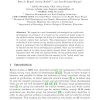Free Online Productivity Tools
i2Speak
i2Symbol
i2OCR
iTex2Img
iWeb2Print
iWeb2Shot
i2Type
iPdf2Split
iPdf2Merge
i2Bopomofo
i2Arabic
i2Style
i2Image
i2PDF
iLatex2Rtf
Sci2ools
IPMI
2009
Springer
2009
Springer
Identification of Growth Seeds in the Neonate Brain Through Surfacic Helmholtz Decomposition
We report on a new framework to investigate the rapid brain development of newborns. It is based on the analysis of depth maps of the cortical surface through the study of a displacement field estimated by surfacic optical flow methods. This displacement field shows local evolution of sulci directly on the cortical surface. Detection of its critical points is performed with the Helmholtz decomposition which allows us to identify sources of the developmental process. They can be viewed as growth seeds or in other terms points around which the sulcal growth organizes itself. We show the reproducibility of such growth seeds across 4 neonates and make a link of this new concept to the "sulcal roots" one proposed to explain the variability of human brain anatomy.
| Added | 17 Nov 2009 |
| Updated | 17 Nov 2009 |
| Type | Conference |
| Year | 2009 |
| Where | IPMI |
| Authors | François Leroy, Jean-Francois Mangin, Jessica Dubois, Julien Lefevre, Petra S. Huppi, Sheraz Khan, Sylvain Baillet |
Comments (0)

